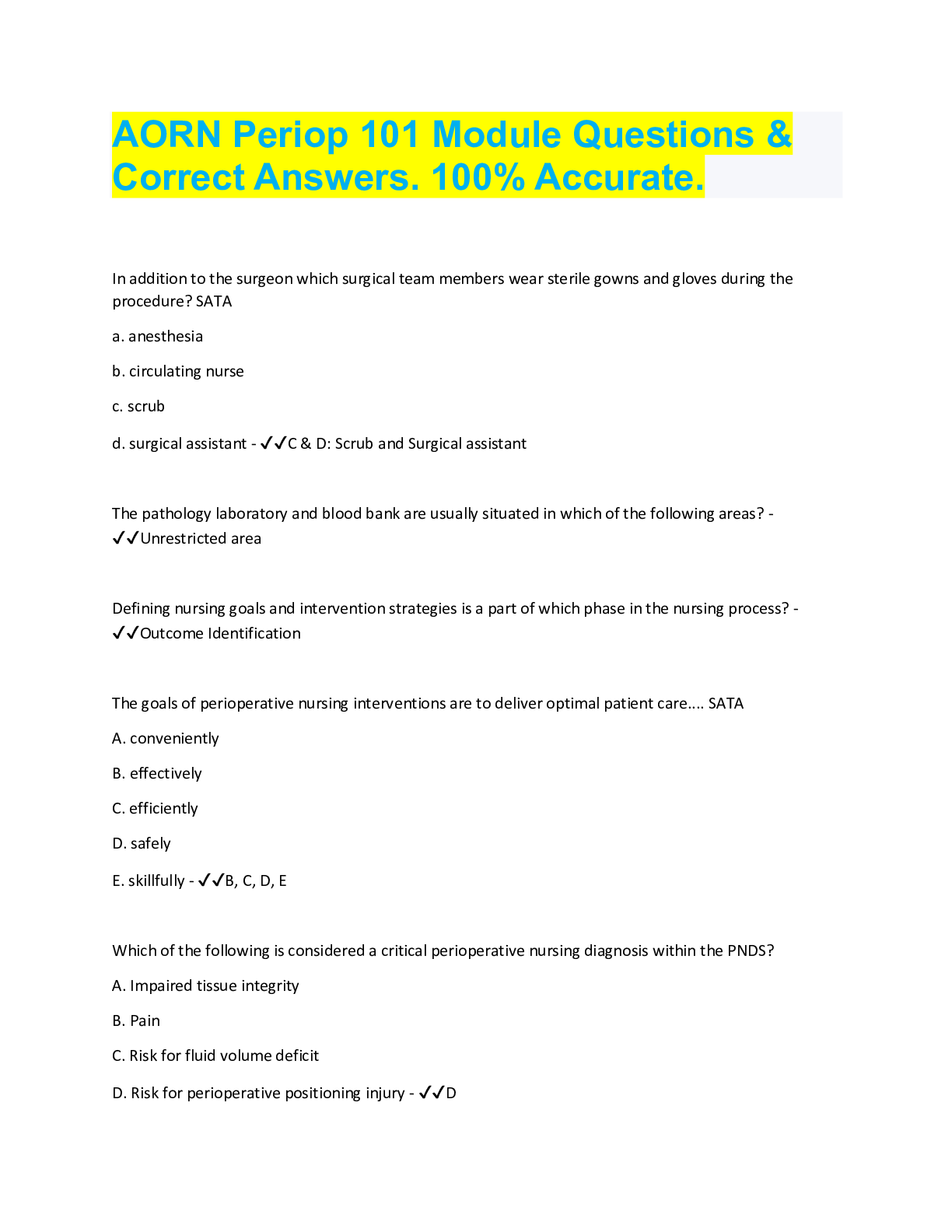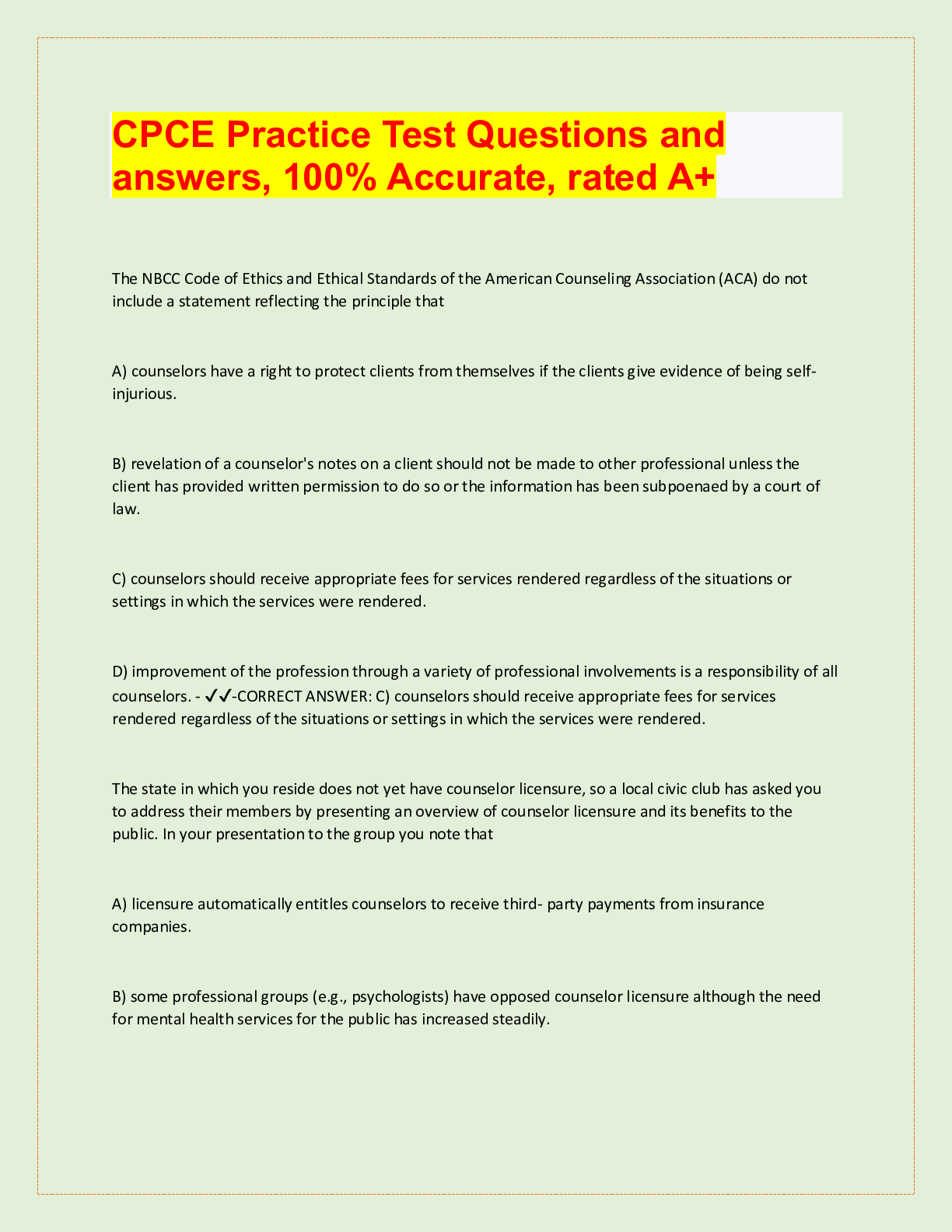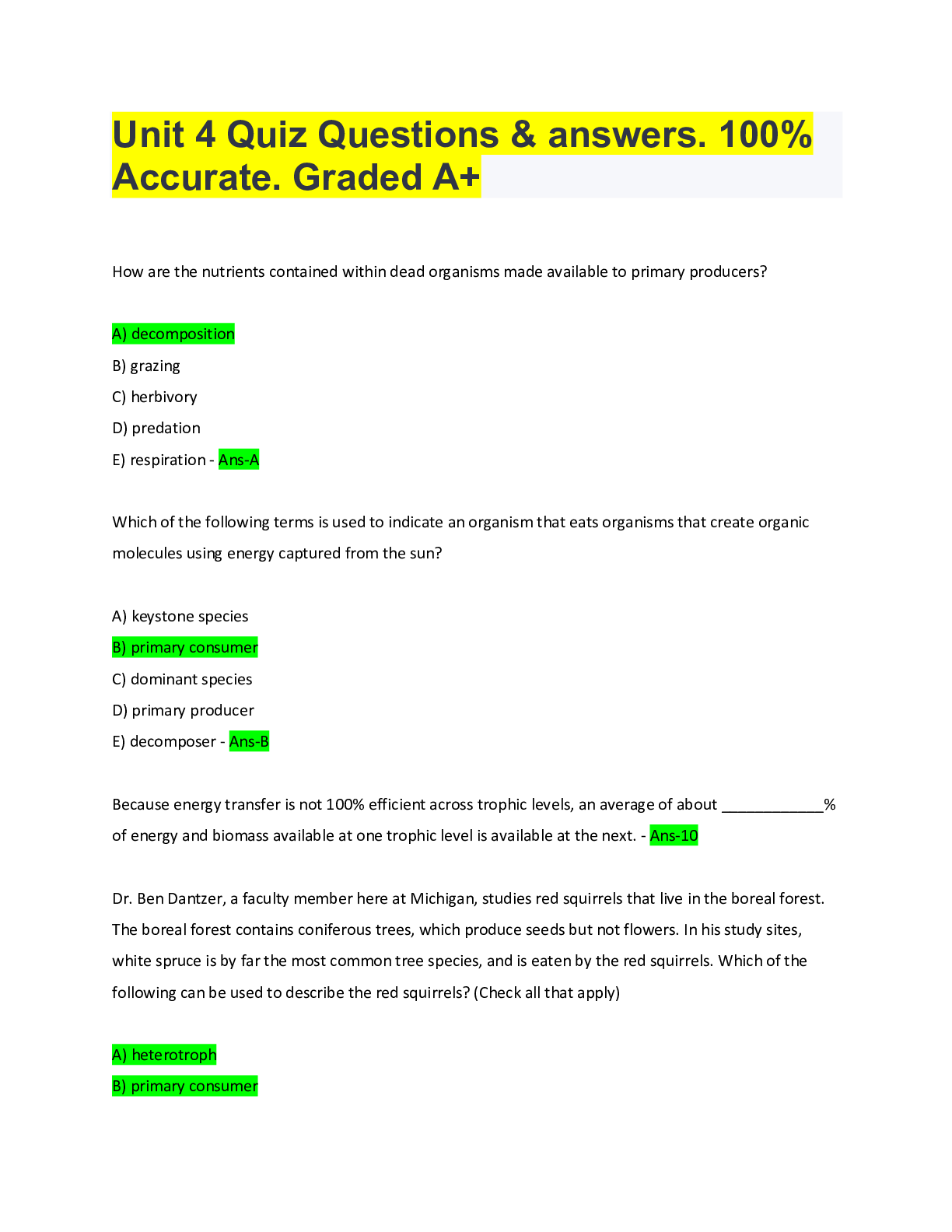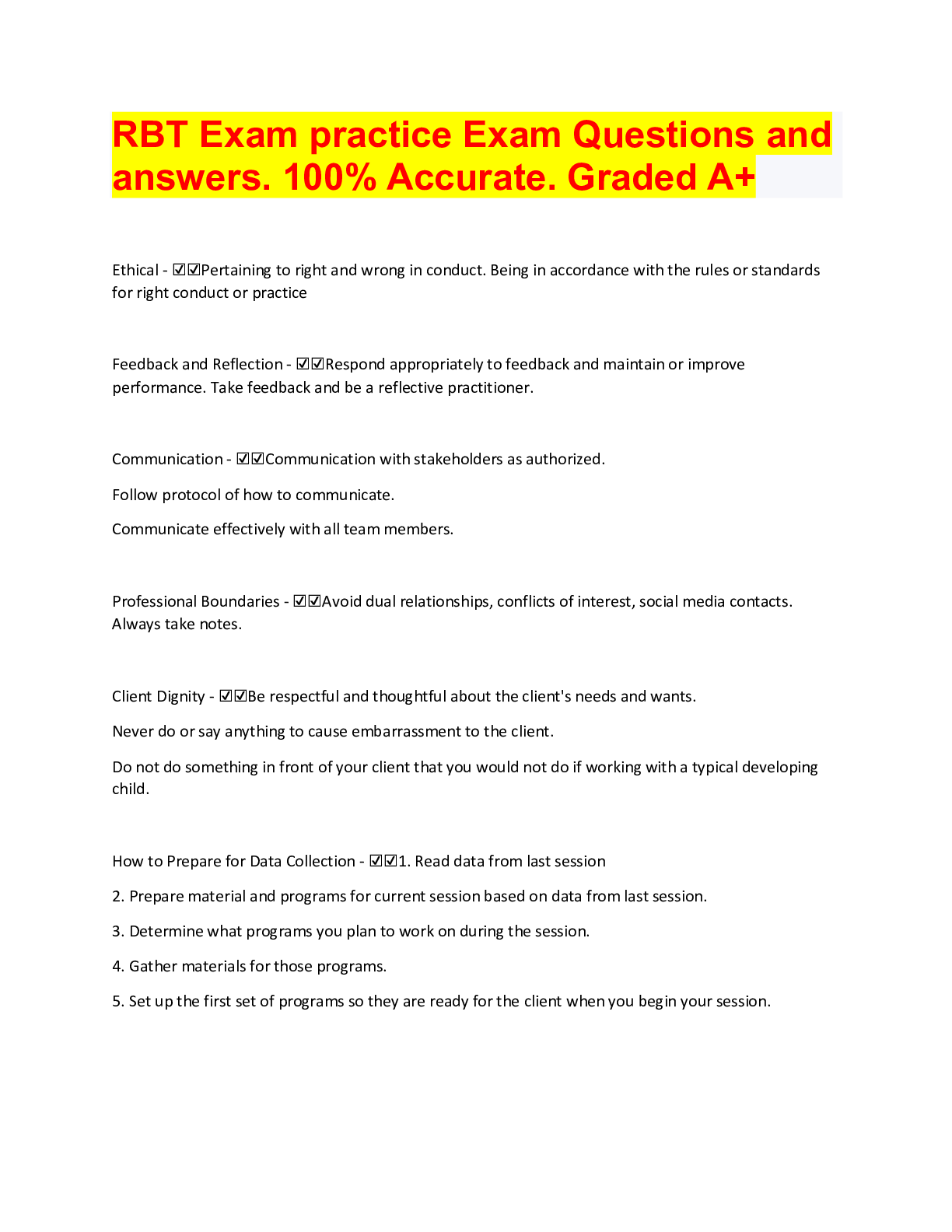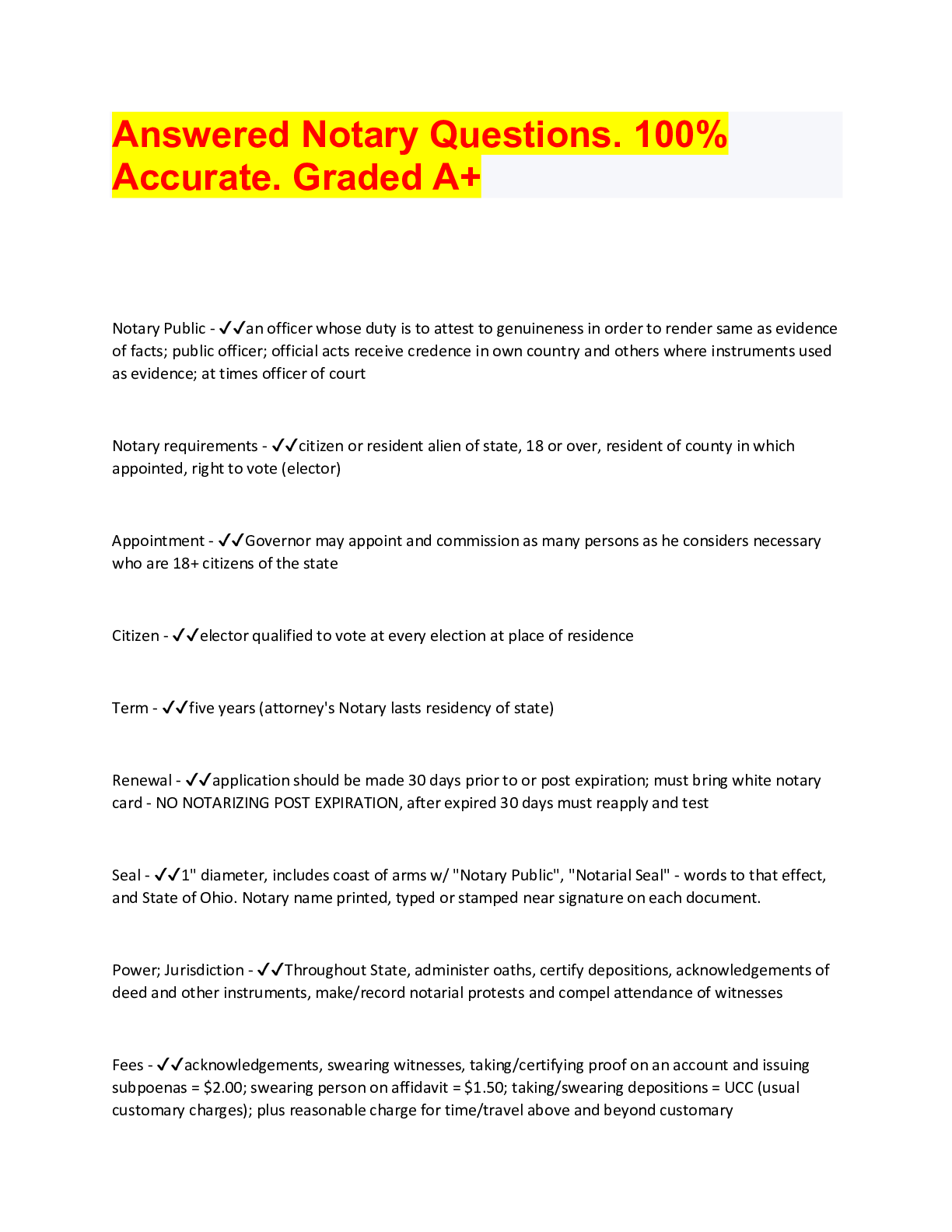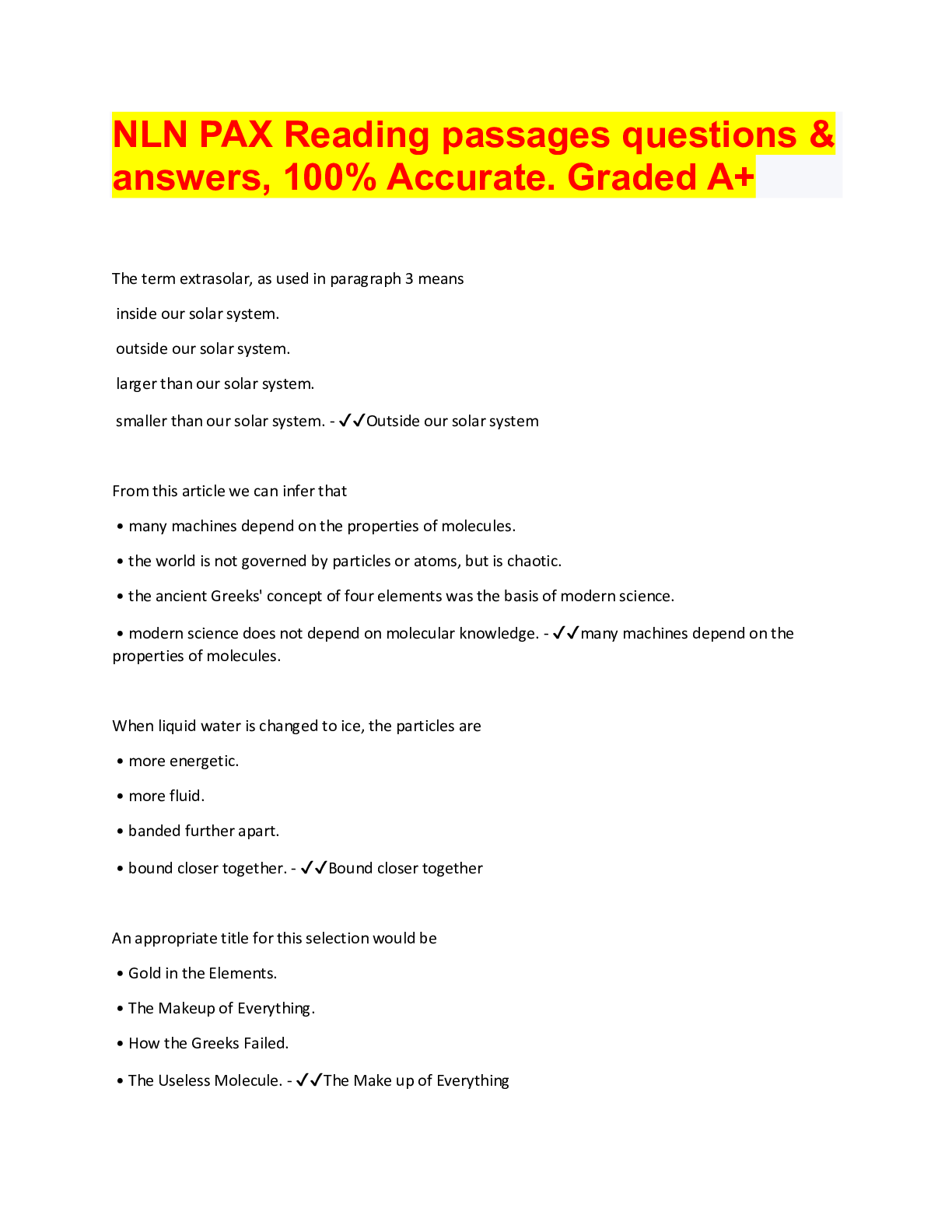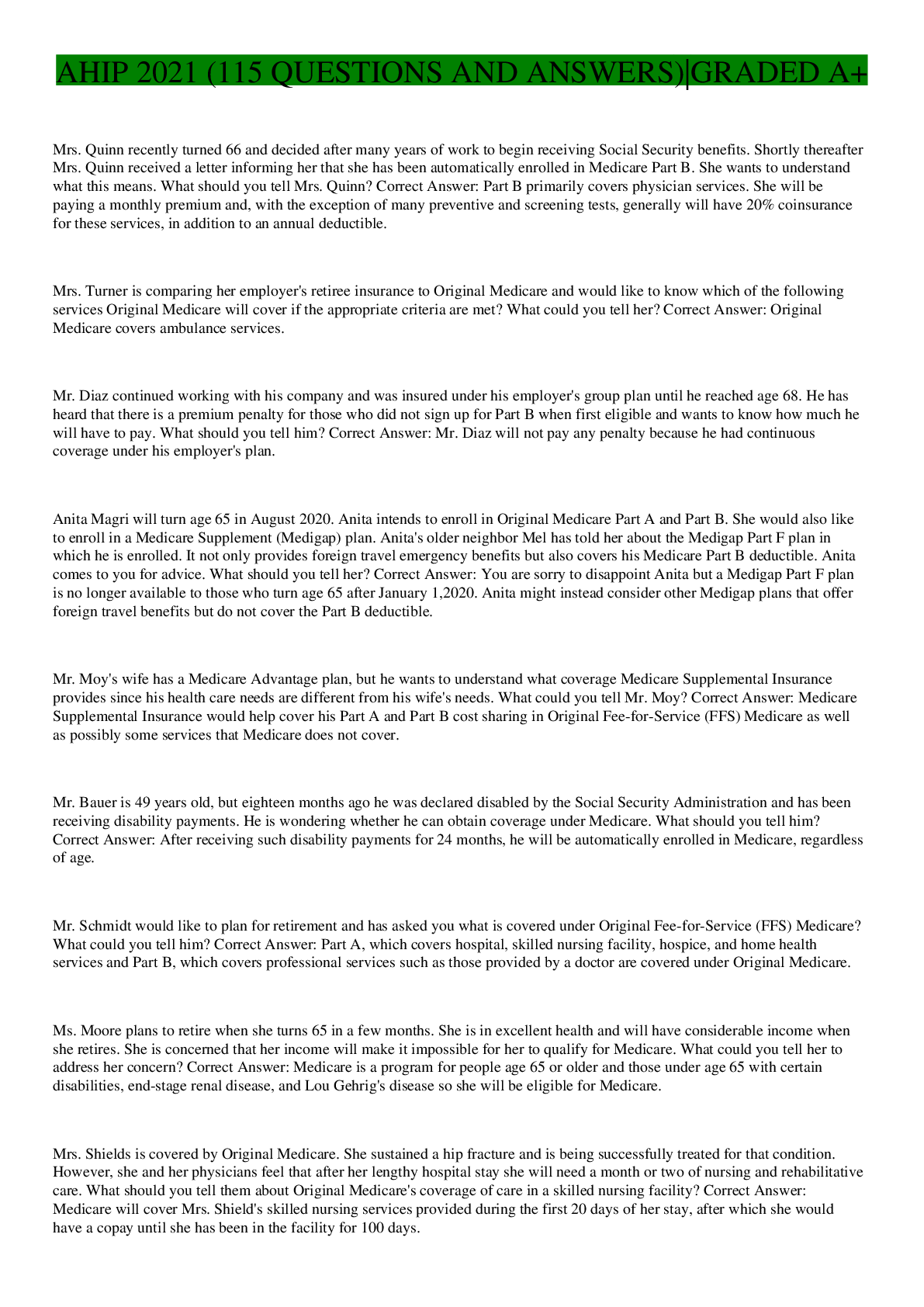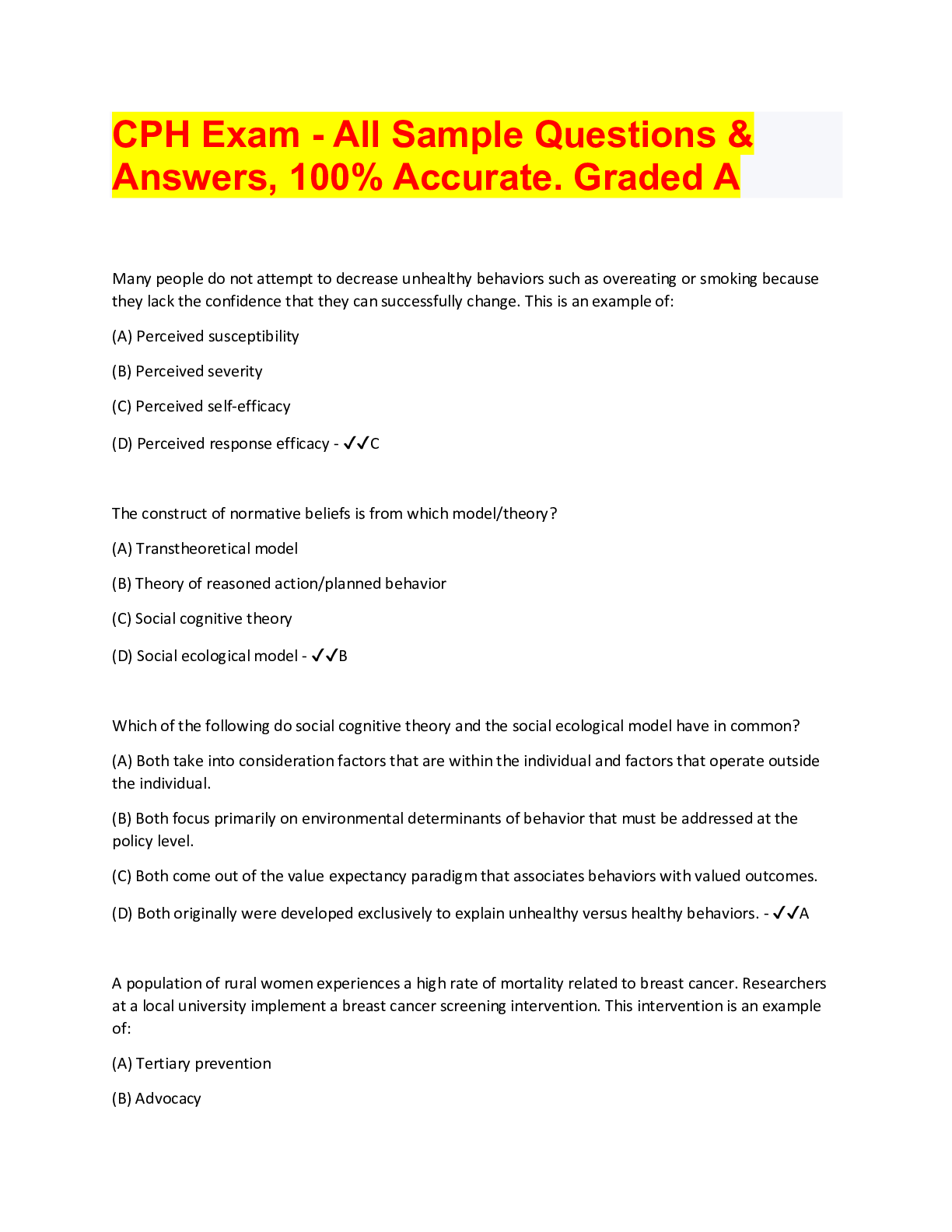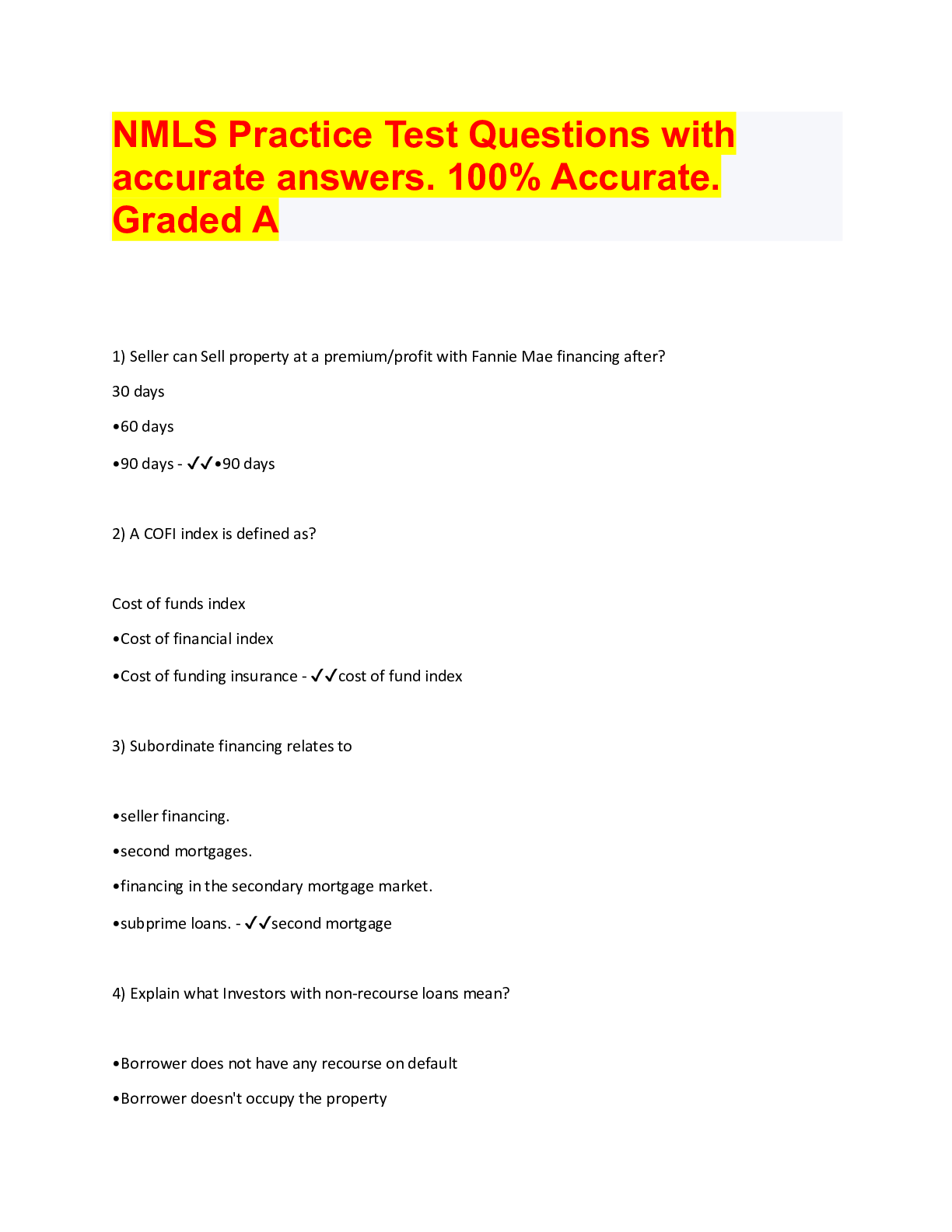Social Sciences > QUESTIONS & ANSWERS > DSM 5, Exam Preview, Questions part coverage. 100% Accurate. Graded A+ (All)
DSM 5, Exam Preview, Questions part coverage. 100% Accurate. Graded A+
Document Content and Description Below
DSM 5, Exam Preview, Questions part coverage. 100% Accurate. Graded A+ Cultural Concepts - ✔✔-In an effort to improve diagnosis and care to people of all backgrounds, the fifth edition of the... Diagnostic and Statistical Manual of Mental Disorders (DSM-5) incorporates a greater cultural sensitivity throughout the manual. Rather than a simple list of culture-bound syndromes, DSM-5 updates criteria to reflect cross-cultural variations in presentations, gives more detailed and structured information about cultural concepts of distress, and includes a clinical interview tool to facilitate comprehensive, person-centered assessments. The Impact of Cultural Differences Different cultures and communities exhibit or explain symptoms in various ways. Because of this, it is important for clinicians to be aware of relevant contextual information stemming from a patient's culture, race, ethnicity, religion or geographical origin. For example, uncontrollable crying and headaches are symptoms of panic attacks in some cultures, while difficulty breathing may be the primary symptom in other cultures. Understanding such distinctions will help clinicians more accurately diagnose problems as well as more effectively treat them. Cultural Considerations in Clinical Practice Throughout the DSM-5 development process, the Work Groups made a concerted effort to modify culturally determined criteria so they would be more equivalent across different cultures. In Section II, specific diagnostic criteria were changed to better apply across diverse cultures. For example, the criteria for social anxiety disorder now include the fear of "offending others" to reflect the Japanese concept in which avoiding harm to others is emphasized rather than harm to oneself. The new manual also addresses cultural concepts of distress, which detail ways in which different cultures describe symptoms. In the Appendix, they are described through cultural syndromes, idioms of distress, and explanations. These concepts assist clinicians in recognizing how people in different cultures think and talk about psychological problems. Finally, the cultural formulation interview guide will help clinicians to assess cultural factors influencing patients' perspectives of their symptoms and treatment options. It includes questions about patients' background in terms of their culture, race, ethnicity, religion or geographical origin. The interview provides an opportunity for individuals to define their distress in their own words and then relate this to how others, who may not share their culture, see their problems. This gives the clinician a more comprehensive foundation on which to base both diagnosis and care. DSM-V Diagnoses for Children - ✔✔-The fifth edition of the Diagnostic and Statistical Manual of Mental Disorders (DSM-5) updates disorder criteria to more precisely capture the experiences and symptoms of children. The book also features a new lifespan approach to mental health. Rather than isolating childhood conditions, DSM-5's organization underscores how they can continue to manifest at different stages of life and may be impacted by the developmental continuum that influences many disorders. Changes affecting children are evident before the manual's first page of text. Its table of contents reflects a new framework that recognizes age-related aspects of disorders by arranging each diagnostic chapter in a chronological fashion, with diagnoses most applicable to infancy and childhood listed first, followed by diagnoses more common to adolescence and early adulthood, and ending with those relevant to adulthood and later years. Thus, disorders previously addressed in a single "infancy, childhood and adolescence" chapter are now integrated throughout the book. Individual disorders, diagnostic categories and criteria were revised to better serve young patients. In revising DSM-5, several factors motivated the Work Groups, including: • Working with parents • Defining a diagnostic home • Developing more precise criteria Parents' Integral Role Throughout the development process for DSM-5, family and consumer advocacy organizations served an important function in giving feedback on proposed changes and, in some cases, meeting with members of the DSM-5 Work Groups. All revisions to the manual were made to more precisely describe and diagnose the symptoms and behaviors of those seeking clinical help. Parents provided a particularly valuable perspective on the framing around changes. DSM-5 is a clinical guidebook for assessment and diagnosis of mental disorders and does not include treatment guidelines or recommendations on services. That said, determining an accurate diagnosis is the first step toward appropriate care. As with any medical issue, no child should ever be diagnosed without a careful, comprehensive evaluation, and no medication should be prescribed without equal vigilance. Parents play an integral role in this process as many of the DSM criteria require that symptoms be observed by them or individuals who interact regularly with the child. It is both appropriate and essential for parents to ask questions and provide information to clinicians during a child's assessment. Parents' specific questions about their child's care should always be discussed with the child's mental health clinician or pediatrician. A Diagnostic Home Clinicians and families often were frustrated that DSM-IV did not define or describe some of the clinically significant behaviors and symptoms they observed in children. In an effort to improve diagnosis and care, two new disorders are among the changes made to DSM-5 to provide children with an accurate diagnostic home. 2 • DSM-5 and Diagnoses for Children Social communication disorder (SCD) is characterized by a persistent difficulty with verbal and nonverbal communication that cannot be explained by low cognitive ability. The child's acquisition and use of spoken and written language is problematic, and responses in conversation are often difficult. Since previous manuals did not provide an applicable diagnosis for individuals with such symptoms, there was inconsistent treatment across clinics and treatment centers. SCD brings these children's social and communication deficits out of the shadows of a "not otherwise specified" or similarly inexact diagnosis. Also added to DSM-5 is disruptive mood dysregulation disorder (DMDD). It is characterized by severe and recurrent temper outbursts that are grossly out of proportion to the situation in intensity or duration. The outbursts occur, on average, three or more times each week for a year or more. The unique features of DMDD necessitated a new diagnosis to ensure that children affected by this disorder get appropriate clinical help. More Precise Criteria Existing criteria have been updated in DSM-5 to provide more precise descriptions and reflect the scientific advances and clinical experience of the last two decades. Below are brief summaries of changes to select disorders. Autism spectrum disorder (ASD) incorporates four disorders from the previous manual: autistic disorder, Asperger's disorder, childhood disintegrative disorder, and the catch-all diagnosis of pervasive developmental disorder not otherwise specified. Researchers found that those four diagnoses were inconsistently applied across clinics and treatment centers and, rather than distinct disorders, actually represented symptoms and behaviors along a severity continuum. ASD reflects that continuum and is a more accurate and medically and scientifically useful approach. People diagnosed with one of the separate DSM-IV disorders should still meet the criteria for autism spectrum disorder or a different DSM-5 diagnosis. Attention deficit/hyperactivity disorder (ADHD) now requires an individual's symptoms to be present prior to age 12, compared to 7 as the age of onset in DSM-IV. Substantial research published since 1994 found no clinical differences between children with earlier versus later symptom onset in terms of their disorder course, severity, outcome, or treatment response. Other criteria for diagnosing children with ADHD remain unchanged. Posttraumatic Stress Disorder (PTSD) includes a new subtype for children younger than 6. This change is based on recent research detailing what PTSD looks like in young children. Adding the developmental subtype should help clinicians tailor treatment in a more age-appropriate and age-effective way. Specific Learning Disorder no longer limits learning disorders to reading, mathematics and written expression. Rather, the DSM-5 criteria describe shortcomings in general academic skills and provide detailed specifiers. Just as in DSM-IV, dyslexia is included in the descriptive text. Eating disorders previously listed among Disorders Usually First Diagnosed in Infancy, Childhood, or Adolescence are now listed in the Feeding and Eating Disorders chapter. They include pica, rumination and avoidant/restrictive food intake disorder. DSM-5 and Diagnoses for Children • 3 Section III of DSM-5 lists conditions warranting more scientific research and clinical experience before they might be considered for inclusion in the main book as formal disorders. Two conditions listed here are particularly relevant for children and adolescents; both are regarded as major problems and public health issues that need to be better understood. Nonsuicidal self-injury defines self-harm without the intention of suicide. Internet gaming disorder deals with the compulsive preoccupation some people develop in playing online games, often to the exclusion of other needs and interests. More information about children with these and other challenging behaviors is available from: • American Academy of Child and Adolescent Psychiatry at www.aacap.org • The Balanced Mind Foundation at www.thebalancedmind.org • National Alliance on Mental Illness at www.nami.org • Mental Health America at www.mentalhealthamerica.net. Integrated (Dimensional) Assessment Process - ✔✔-The upcoming fifth edition of the Diagnostic and Statistical Manual of Mental Disorders (DSM-5) introduces an integration of a dimensional approach to diagnosis and classification with the current categorical approach. Previous editions of DSM used a strictly categorical model requiring a clinician to determine that a disorder was present or absent. The dimensional approach, which allows a clinician more latitude to assess the severity of a condition and does not imply a concrete threshold between "normality" and a disorder, is now incorporated via select diagnoses. Its inclusion will also provide more utility in research contexts. Disorders on a Spectrum While all disorders in DSM-5 remain in specific categories, measures indicating degree of acuteness have been added to several combined diagnoses. For example, autism spectrum disorder (ASD) combines four different categorical disorders and conceptualizes them as occurring along a single spectrum focused on dysfunctional social communication and restricted, repetitive behaviors or interests. Under DSM-IV, patients with such symptoms could be diagnosed with autistic disorder, Asperger's disorder, childhood disintegrative disorder, or the catch-all diagnosis of pervasive developmental disorder not otherwise specified. But the diagnoses were not consistently applied across practices and treatment centers, in large part because they shared such similar characteristics. Researchers determined that these separate disorders are actually related conditions along a single continuum of behavior. With ASD, some individuals show mild symptoms and others have much more severe symptoms. This spectrum will allow clinicians to account for such variations from person to person. Another example of continuum-based assessment is evident in the new diagnosis of substance use disorder. DSM-5 combines two separate diagnoses of abuse and dependence into a single spectrum of eleven symptoms. In DSM-IV, the distinction between abuse and dependence was based on the concept of abuse as a mild or early phase and dependence as the more severe manifestation. In practice, that was an arbitrary dichotomy, as the abuse criteria were sometimes quite severe. The revised substance use disorder better matches the symptoms that patients experience. Building on Symptoms as the Foundation for Care Using assessment models that also focus attention on the acuteness of symptoms helps clinicians gather more information and thus more insight in creating a treatment plan. The narrow categorical approach of previous DSM editions constricted the range of clinical information obtained, which often could have significant implications for diagnosis, treatment planning, prognosis, and outcomes. With greater depth of detail about symptoms—instead of simply marking them as present or absent— DSM-5 will reduce the excess number of patients who would have been diagnosed under DSM-IV's categorical approach as having a "not otherwise specified" diagnosis due to failure to meet thresholds (e.g., patients with mild symptoms who might not fulfill threshold symptom counts but are in need of treatment). Rather, the integrated approach moves these patients out of the "not otherwise specified" 2 • DSM-5's Integrated Approach to Diagnosis and Classification category by tailoring their diagnosis to the particulars of each individual and providing a diagnosis that is more informative and conducive to treatment planning than the residual diagnosis of "not otherwise specified". Patients often do not fit precisely into one category or another, and the use of a spectrum in DSM-5 mitigates that problem. Assessing on a spectrum also has benefits for research because the data it produces is more reliable, stable and valid. Spectrum models are also preferred for hypothesis development and testing. To ensure DSM-5 is not overly disruptive to clinical practice, its spectrum measures are compatible with categorical definitions. The new edition combines the best of both categorical and dimensional approaches to provide better guidance to clinicians and, as a consequence better treatment to patients. Mixed Features Specifier - ✔✔-The upcoming fifth edition of the Diagnostic and Statistical Manual of Mental Disorders (DSM-5) will replace the diagnosis of "mixed episode" with a mixed-features specifier that can be applied to episodes of major depression, hypomania or mania. The change reflects ways these behaviors intersect and will benefit diagnosis and care. In DSM-IV, a diagnosis of mixed episode required an individual to simultaneously meet all criteria for an episode of major depression and an episode of mania. During its review of the latest research, the DSM-5 Mood Disorders Work Group recognized that individuals rarely meet full criteria for both episode types at the same time. In order to be diagnosed with the new specifier in the case of major depression, the new DSM-5 specifier will require the presence of at least three manic/hypomanic symptoms that don't overlap with symptoms of major depression. In the case of mania or hypomania, the specifier will require the presence of at least three symptoms of depression in concert with the episode of mania/hypomania. Using the Specifiers If an individual is predominantly manic or hypomanic but also presents with depressive symptoms, the mixed features specifier may be considered. Depressive symptoms may include depressed mood, diminished interest or pleasure, slowed physical and emotional reaction, fatigue or loss of energy, and recurrent thoughts of death. At least three of these symptoms must be present nearly every day during the most recent week of a manic episode or during the most recent four days of a hypomanic episode. Conversely, if an individual is predominantly depressed with some manic or hypomanic symptoms, the mixed features specifier may also be considered. These manic or hypomanic symptoms may include elevated mood, inflated self-esteem, decreased need for sleep and an increase in energy or goal-directed activity. At least three of these symptoms must be present nearly every day during the most recent two weeks of the major depressive episode. Improving Diagnosis and Care The specifier will allow clinicians to more accurately diagnose patients who may be suffering from concurrent symptoms of depression and mania/hypomania, as well as better tailor treatment to their behaviors. This is especially important since many patients with mixed features, depending on their predominant symptoms, demonstrate poor response to lithium or become less stable when taking antidepressants. Additionally, more accurately identifying these concurrent behaviors may allow clinicians to recognize people with a unipolar disorder at increased risk of progression to bipolar disorder. Neurodevelopmental Disorders - ✔✔--Intellectual Disability (Intellectual Developmental Disorder) -Communication Disorders -Autism Spectrum Disorder -Attention-Deficit/Hyperactivity Disorder -Specific Learning Disorder -Motor Disorders Intellectual Disability (Intellectual Developmental Disorder) - ✔✔-emphasize the need for an assessment of both cognitive capacity (IQ) and adaptive functioning. Severity is determined by adaptive functioning rather than IQ score. The term mental retardation was used in DSM-IV. However, intellectual disability is the term that has come into common use over the past two decades among medical, educational, and other professionals, and by the lay public and advocacy groups. Moreover, a federal statue in the United States (Public Law 111-256, Rosa's Law) replaces the term "mental retardation with intellectual disability. Despite the name change, the deficits in cognitive capacity beginning in the developmental period, with the accompanying diagnostic criteria, are considered to constitute a mental disorder. Because the ICD-11 will not be adopted for several years, intellectual disability was chosen as the current preferred term with the bridge term for the future in parentheses. Communication Disorders - ✔✔-The DSM-5 communication disorders include language disorder (which combines DSM-IV expressive and mixed receptive-expressive language disorders), speech sound disorder (a new name for phonological disorder), and childhood-onset fluency disorder (a new name for stuttering). Also included is social (pragmatic) communication disorder, a new condition for persistent difficulties in the social uses of verbal and nonverbal communication. Because social communication deficits are one component of autism spectrum disorder (ASD), it is important to note that social (pragmatic) communication disorder cannot be diagnosed in the presence of restricted repetitive behaviors, interests, and activities (the other component of ASD). The symptoms of some patients diagnosed with DSM-IV pervasive developmental disorder not otherwise specified may meet the DSM-5 criteria for social communication disorder. Autism Spectrum Disorder - ✔✔-Autism spectrum disorder is a new DSM-5 name that reflects a scientific consensus that four previously separate disorders are actually a single condition with different levels of symptom severity in two core 2 • Highlights of Changes from DSM-IV-TR to DSM-5 domains. ASD now encompasses the previous DSM-IV autistic disorder (autism), Asperger's disorder, childhood disintegrative disorder, and pervasive developmental disorder not otherwise specified. ASD is characterized by 1) deficits in social communication and social interaction and 2) restricted repetitive behaviors, interests, and activities (RRBs). Because both components are required for diagnosis of ASD, social communication disorder is diagnosed if no RRBs are present. Attention-Deficit/Hyperactivity Disorder - ✔✔-The diagnostic criteria for attention-deficit/hyperactivity disorder (ADHD) in DSM-5 are similar to those in DSM-IV. The same 18 symptoms are used as in DSM-IV, and continue to be divided into two symptom domains (inattention and hyperactivity/impulsivity). However, several changes have been made in DSM-5: 1) examples have been added to the criterion items to facilitate application across the life span; 2) the cross-situational requirement has been strengthened to "several" symptoms in each setting; 3) the onset criterion has been changed from "symptoms that caused impairment were present before age 7 years" to "several inattentive or hyperactive-impulsive symptoms were present prior to age 12"; 4) subtypes have been replaced with presentation specifiers that map directly to the prior subtypes; 5) a comorbid diagnosis with autism spectrum disorder is now allowed; and 6) a symptom threshold change has been made for adults, to reflect their substantial evidence of clinically significant ADHD impairment, with the cutoff for ADHD of five symptoms, instead of six required for younger persons, both for inattention and for hyperactivity and impulsivity. Finally, ADHD was placed in the neurodevelopmental disorders chapter to reflect brain developmental correlates with ADHD and the DSM-5 decision to eliminate the DSM-IV chapter that includes all diagnoses usually first made in infancy, childhood, or adolescence. Specific Learning Disorder - ✔✔-Specific learning disorder combines the DSM-IV diagnoses of reading disorder, mathematics disorder, disorder of written expression, and learning disorder not otherwise specified. Because learning deficits in the areas of reading, written expression, and mathematics commonly occur together, coded specifiers for the deficit types in each area are included. The text acknowledges that specific types of reading deficits are described internationally in various ways as dyslexia and specific types of mathematics deficits as dyscalculia. Motor Disorders - ✔✔-The following motor disorders are included in the DSM-5 neurodevelopmental disorders chapter: developmental coordination disorder, stereotypic movement disorder, Tourette's disorder, persistent (chronic) motor or vocal tic disorder, provisional tic disorder, other specified tic disorder, and unspecified tic disorder. The tic criteria have been standardized across all of these disorders in this chapter. Stereotypic movement disorder has been more clearly differentiated from body-focused repetitive behavior disorders that are in the DSM-5 obsessive-compulsive disorder chapter Schizophrenia Spectrum and Other Psychotic Disorders - ✔✔--Schizophrenia -Schizophrenia subtypes -Schizoaffective Disorder -Delusional Disorder -Catatonia Schizophrenia - ✔✔-Two changes were made to DSM-IV Criterion A for schizophrenia. The first change is the elimination of the special attribution of bizarre delusions and Schneiderian first-rank auditory hallucinations (e.g.,two or more voices conversing). In DSM-IV, only one such symptom was needed to meet the diagnostic requirement for Criterion A, instead of two of the other listed symptoms. This special attribution was Highlights of Changes from DSM-IV-TR to DSM-5 • 3 removed due to the nonspecificity of Schneiderian symptoms and the poor reliability in distinguishing bizarre from nonbizarre delusions. Therefore, in DSM-5, two Criterion A symptoms are required for any diagnosis of schizophrenia. The second change is the addition of a requirement in Criterion A that the individual must have at least one of these three symptoms: delusions, hallucinations, and disorganized speech. At least one of these core "positive symptoms" is necessary for a reliable diagnosis of schizophrenia. Schizophrenia subtypes - ✔✔-The DSM-IV subtypes of schizophrenia (i.e., paranoid, disorganized, catatonic, undifferentiated, and residual types) are eliminated due to their limited diagnostic stability, low reliability, and poor validity. These subtypes also have not been shown to exhibit distinctive patterns of treatment response or longitudinal course. Instead, a dimensional approach to rating severity for the core symptoms of schizophrenia is included in Section III to capture the important heterogeneity in symptom type and severity expressed across individuals with psychotic disorders Schizoaffective Disorder - ✔✔-The primary change to schizoaffective disorder is the requirement that a major mood episode be present for a majority of the disorder's total duration after Criterion A has been met. This change was made on both conceptual and psychometric grounds. It makes schizoaffective disorder a longitudinal instead of a cross-sectional diagnosis—more comparable to schizophrenia, bipolar disorder, and major depressive disorder, which are bridged by this condition. The change was also made to improve the reliability, diagnostic stability, and validity of this disorder, while recognizing that the characterization of patients with both psychotic and mood symptoms, either concurrently or at different points in their illness, has been a clinical challenge. Delusional Disorder - ✔✔-Criterion A for delusional disorder no longer has the requirement that the delusions must be nonbizarre. A specifier for bizarre type delusions provides continuity with DSM-IV. The demarcation of delusional disorder from psychotic variants of obsessive-compulsive disorder and body dysmorphic disorder is explicitly noted with a new exclusion criterion, which states that the symptoms must not be better explained by conditions such as obsessive-compulsive or body dysmorphic disorder with absent insight/delusional beliefs. DSM-5 no longer separates delusional disorder from shared delusional disorder. If criteria are met for delusional disorder then that diagnosis is made. If the diagnosis cannot be made but shared beliefs are present, then the diagnosis "other specified schizophrenia spectrum and other psychotic disorder" is used. Catatonia - ✔✔-The same criteria are used to diagnose catatonia whether the context is a psychotic, bipolar, depressive, or other medical disorder, or an unidentified medical condition. In DSM-IV, two out of five symptom clusters were required if the context was a psychotic or mood disorder, whereas only one symptom cluster was needed if the context was a general medical condition. In DSM-5, all contexts require three catatonic symptoms (from a total of 12 characteristic symptoms). In DSM-5, catatonia may be diagnosed as a specifier for depressive, bipolar, and psychotic disorders; as a separate diagnosis in the context of another medical condition; or as an other specified diagnosis. Bipolar and Related Disorders - ✔✔--Bipolar Disorders -Other Specified Bipolar and Related Disorder -Anxious Distress Specifier Bipolar Disorders - ✔✔-To enhance the accuracy of diagnosis and facilitate earlier detection in clinical settings, Criterion A for manic and hypomanic episodes now includes an emphasis on changes in activity and energy as well as mood. The DSM-IV diagnosis of bipolar I disorder, mixed episode, requiring that the individual simultaneously meet full criteria for both mania and major depressive episode, has been removed. Instead, a new specifier, "with mixed features," has been added that can be applied to episodes of mania or hypomania when depressive features are present, and to episodes of depression in the context of major depressive disorder or bipolar disorder when features of mania/hypomania are present. Other Specified Bipolar and Related Disorder - ✔✔-DSM-5 allows the specification of particular conditions for other specified bipolar and related disorder, including categorization for individuals with a past history of a major depressive disorder who meet all criteria for hypomania except the duration criterion (i.e., at least 4 consecutive days). A second condition constituting an other specified bipolar and related disorder is that too few symptoms of hypomania are present to meet criteria for the full bipolar II syndrome, although the duration is sufficient at 4 or more days. Anxious Distress Specifier - ✔✔-In the chapter on bipolar and related disorders and the chapter on depressive disorders, a specifier for anxious distress is delineated. This specifier is intended to identify patients with anxiety symptoms that are not part of the bipolar diagnostic criteria Depressive Disorder CHANGES - ✔✔-DSM-5 contains several new depressive disorders, including disruptive mood dysregulation disorder an [Show More]
Last updated: 1 year ago
Preview 1 out of 41 pages
Instant download
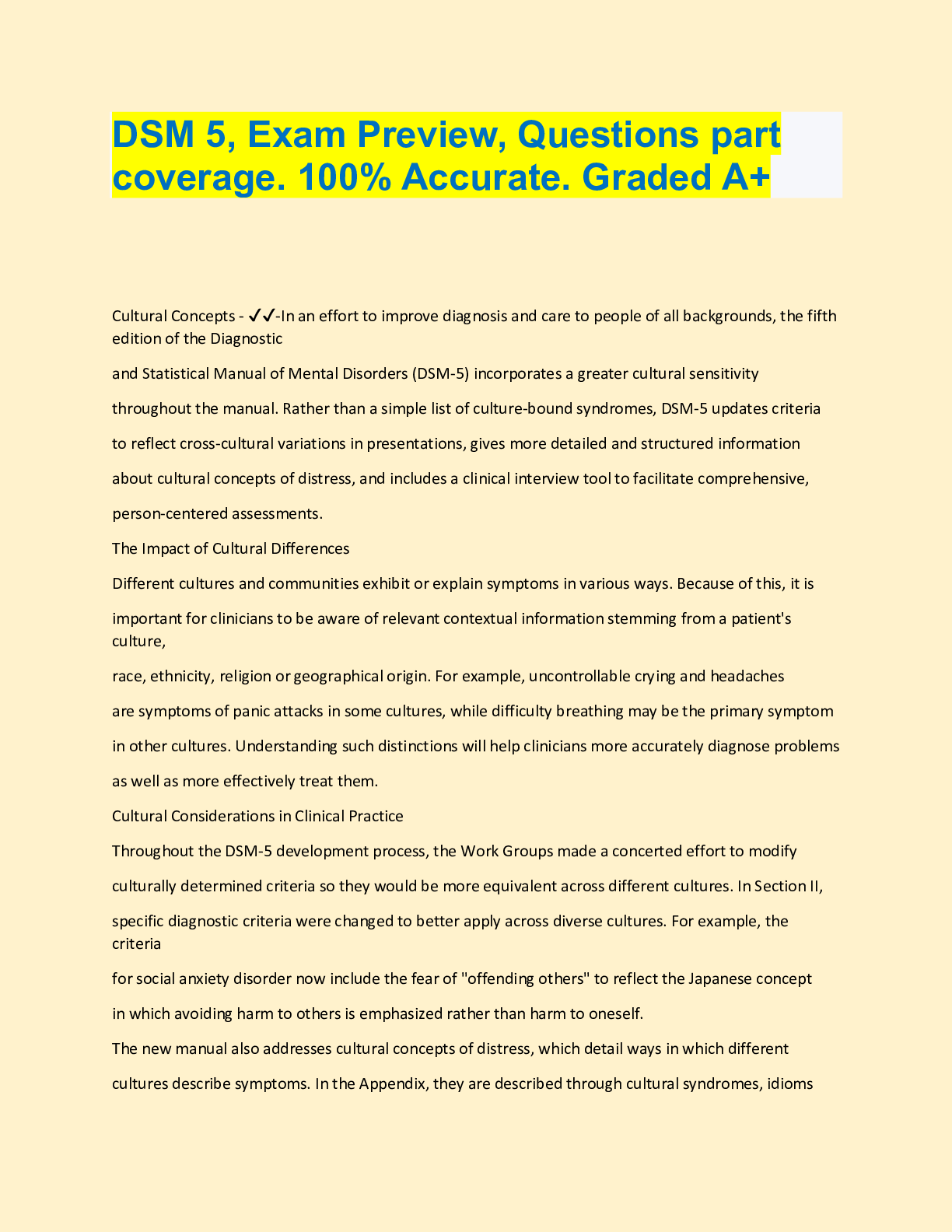
Buy this document to get the full access instantly
Instant Download Access after purchase
Add to cartInstant download
Also available in bundle (1)

DSM 5 Review Bundle, top Questions Exam. verified.
DSM 5 Review Questions and answers, 100% Accurate, rated A+. verified exam predictions.
By Topmark 1 year ago
$38
18
Reviews( 0 )
Document information
Connected school, study & course
About the document
Uploaded On
Mar 14, 2023
Number of pages
41
Written in
Additional information
This document has been written for:
Uploaded
Mar 14, 2023
Downloads
0
Views
73






